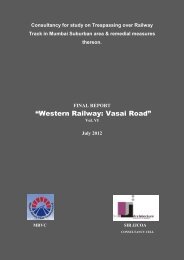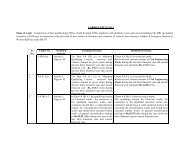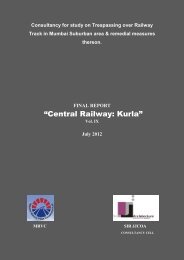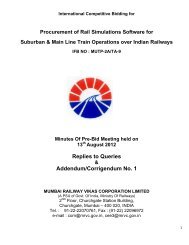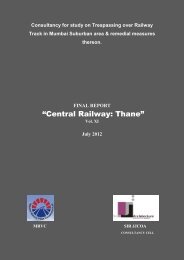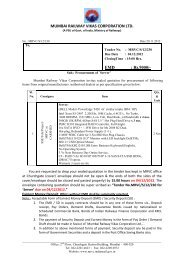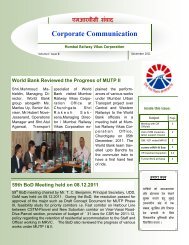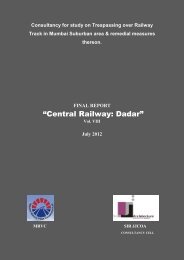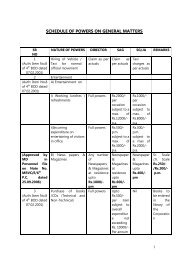World Bank Document - Mumbai Railway Vikas Corporation Ltd ...
World Bank Document - Mumbai Railway Vikas Corporation Ltd ...
World Bank Document - Mumbai Railway Vikas Corporation Ltd ...
You also want an ePaper? Increase the reach of your titles
YUMPU automatically turns print PDFs into web optimized ePapers that Google loves.
25. The on-going MUTP-1 project has made significant progress towards achieving<br />
its development objectives with a noted reduction in overcrowding in suburban trains and<br />
operation of new buses of improved design. The MMR Development Authority (MMRDA) has<br />
improved its capacity to manage resettlement and rehabilitation that is now implemented with<br />
reasonable quality. But land acquisition and resettlement and rehabilitation are still slow, as is<br />
road construction.<br />
26. The design of MUTP-2A builds on the following key lessons learned from the<br />
implementation of MUTP-1 and other transport operations in India.<br />
27. Motivation, ownership, effective implementation planning and sustained followup<br />
on the part of the client is an important factor in implementation success. MRVC, which<br />
started off as a new entity has in course of implementing MUTP-1 developed management<br />
experience, expertise in <strong>Bank</strong>-assisted operations and capacity to liaise with the several<br />
departments and agencies of IR 2 , GOM, and other stakeholders for implementing the project’s<br />
suburban rail component. This experience has given MRVC the required understanding and<br />
confidence to implement a new externally-funded project on its own in coordination with other<br />
institutions and agencies.<br />
28. The project should be designed in a way that inter-agency coordination does not<br />
become an obstacle to carrying out key activities. One of the key reasons explaining the slow<br />
pace of MUTP-1’s implementation was the complex project design with ambitious<br />
implementation arrangements, involving multiple implementing agencies without effective<br />
coordination. Five project implementing agencies were involved, with MMRDA as the<br />
coordinator. It would have benefitted from a clearer contractual co-ordination framework to<br />
ensure effective progress. Long delays in project components such as station area improvement<br />
schemes and road-over-bridges, requiring greater inter-agency coordination, forced the removal<br />
of these sub-projects from MUTP-1 as part of a project restructuring. To minimize such delays<br />
on account of weak co-operation and ineffective inter-agency coordination, MUTP-2A has been<br />
designed as a simple but comprehensive project for enhancing the quality and magnitude of the<br />
<strong>Mumbai</strong> suburban rail operations, through activities that will involve essentially IR agencies<br />
coordinated by MRVC. Implementation arrangements for MUTP-2A have been planned in such<br />
a way that progress will not be vulnerable to poor inter-agency coordination.<br />
29. Project design should adequately focus on capacity building of the client,<br />
especially in new areas, and leave space for implementation arrangements to evolve, instead of<br />
being frozen in time, to achieve greater efficiency. The nature and significance of some major<br />
resettlement difficulties were appreciated by the client during the process of implementation.<br />
Through very active <strong>Bank</strong> involvement, MMRDA has gradually evolved a more sustainable and<br />
2 Central <strong>Railway</strong> and Western <strong>Railway</strong> are two of the largest and busiest of the 16 zones of Indian <strong>Railway</strong>s. Their<br />
respective divisions, <strong>Mumbai</strong> Division of the Central <strong>Railway</strong> and <strong>Mumbai</strong> Central Division of the Western<br />
<strong>Railway</strong>, are involved in this project. IR is a department owned and controlled by GOI, via MOR. IR manufactures<br />
much of its rolling stock and heavy engineering components at its six manufacturing plants, called production units,<br />
which are managed directly by the Ministry. Chennai ICF is one of these. Each of the six production units is headed<br />
by a general manager, who reports directly to the <strong>Railway</strong>s Board. The Research Design and Standards Organization<br />
(RDSO) is a research and development organization under MOR, which functions as a technical adviser and<br />
consultant to the <strong>Railway</strong>s Board, the zonal railways, and the railway production units in respect of design and<br />
standardization of railway equipment and problems related to railway construction, operation and maintenance.<br />
6





